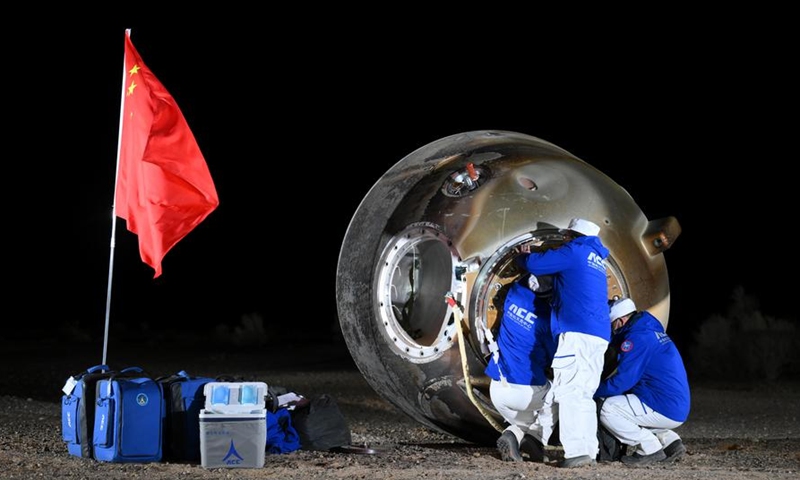
The return capsule of the Shenzhou-18 manned spaceship, carrying taikonauts Ye Guangfu, Li Cong and Li Guangsu, touches down at the Dongfeng landing site in North China's Inner Mongolia Autonomous Region, on November 4, 2024. Photo: Xinhua
The Shenzhou-18 crew consisting of three taikonauts returned to Earth safely in the early morning on Monday, after completing a six-month space station mission. The three taikonauts, after staying in orbit for 192 days, were all in good health and the Shenzhou-18 manned mission was a success, the CMSA said.
Shenzhou-18's return capsule, carrying taikonauts Ye Guangfu, Li Cong and Li Guangsu, touched down at the Dongfeng landing site in North China's Inner Mongolia Autonomous Region at 1:24 am (Beijing Time). The crew exited the capsule by 2:15 am, according to the CMSA.
The taikonauts safely arrived in Beijing on Monday for isolation and recovery, with medical examinations and a press conference scheduled, CMSA said.
Ye, the Shenzhou-18 mission commander, has become the first Chinese astronaut with a cumulative spaceflight time of more than a year, setting a new record for the longest duration of stay in orbit by a Chinese astronaut.
He served as a crew member in the Shenzhou-13 mission from October 2021 to April 2022.
"Chinese astronauts have flown to space in successive missions. I believe that the record of the duration in orbit will be broken in the near future," Ye said.
Li Cong, who has just completed his first-ever space adventure, said that the crew was united as one and worked closely with the ground team, which ensured the extravehicular activities implemented smoothly and the scientific research and experiments progressed successfully.
"We have all enjoyed the unique experience of weightlessness. It is exciting to return to Earth, but we are also unwilling to part the wonders of the space," said Li Guangsu, who has just returned from his first spaceflight.
At 12:34 am, the Beijing Aerospace Control Center issued a return command through the ground station, and the return capsule of the Shenzhou-18 manned spaceship separated from its orbiting capsule. The brake engine then ignited, and the return capsule separated from the propulsion capsule.
The ground search team arrived at the landing site soon after the return capsule landed.
China launched the Shenzhou-18 manned spaceship on April 25, 2024. During the mission, the Shenzhou-18 crew utilized the scientific experiment cabinets and extravehicular payloads to carry out dozens of experiments in the fields of basic physics in microgravity, space material science, space life science, space medicine and space technology.
They replaced the burner for the gas experiment in the combustion experiment cabinet and test samples in the fluid physics experiment cabinet as planned. They also conducted in-orbit training on spacecraft rendezvous and docking.
The Shenzhou-18 astronauts carried out extravehicular activities twice. Their first spacewalk in May set a new record for the longest single spacewalk by taikonauts.
The crew also carried out emergency decision-making research. By utilizing the computer and corresponding software, they completed a series of assessments, including tests on basic cognitive ability, risk perception, decision-making style, as well as comprehensive decision-making tasks.
The ground personnel then used the test results to thoroughly evaluate the astronauts' emergency decision-making ability in orbit and study the influence of the factors such as the duration of stay in orbit, emotional state and workload on their ability.
During their space adventure, the Shenzhou-18 trio also experienced some special joy brought by the space "aquarium" and "garden" in the Tiangong space station.
The three taikonauts created a space "aquarium" using zebrafish and algae to study how the space environment affects their growth and system balance. It was also a breakthrough in the field of raising vertebrates in space.
The taikonauts discovered that zebrafish exhibited abnormal orientation behaviors in microgravity, such as upside-down swimming, spinning and circling.
Before their return to Earth, the Shenzhou-18 crew completed the removal of some module plants, replenishing water and other operations for the "space garden," in preparation for the new batch of plant seeds brought into space by the Shenzhou-19 astronauts.
They also planted a new batch of lettuce for the Shenzhou-19 crew, who were lifted off aboard the Shenzhou-19 spaceship and entered the Tiangong space station on October 30.
In 2025, China's manned space program will launch the Shenzhou-20 and Shenzhou-21 crewed missions, and the Tianzhou-9 cargo craft to deliver in-orbit supplies, the CMSA said.
Xinhua-Global Times




